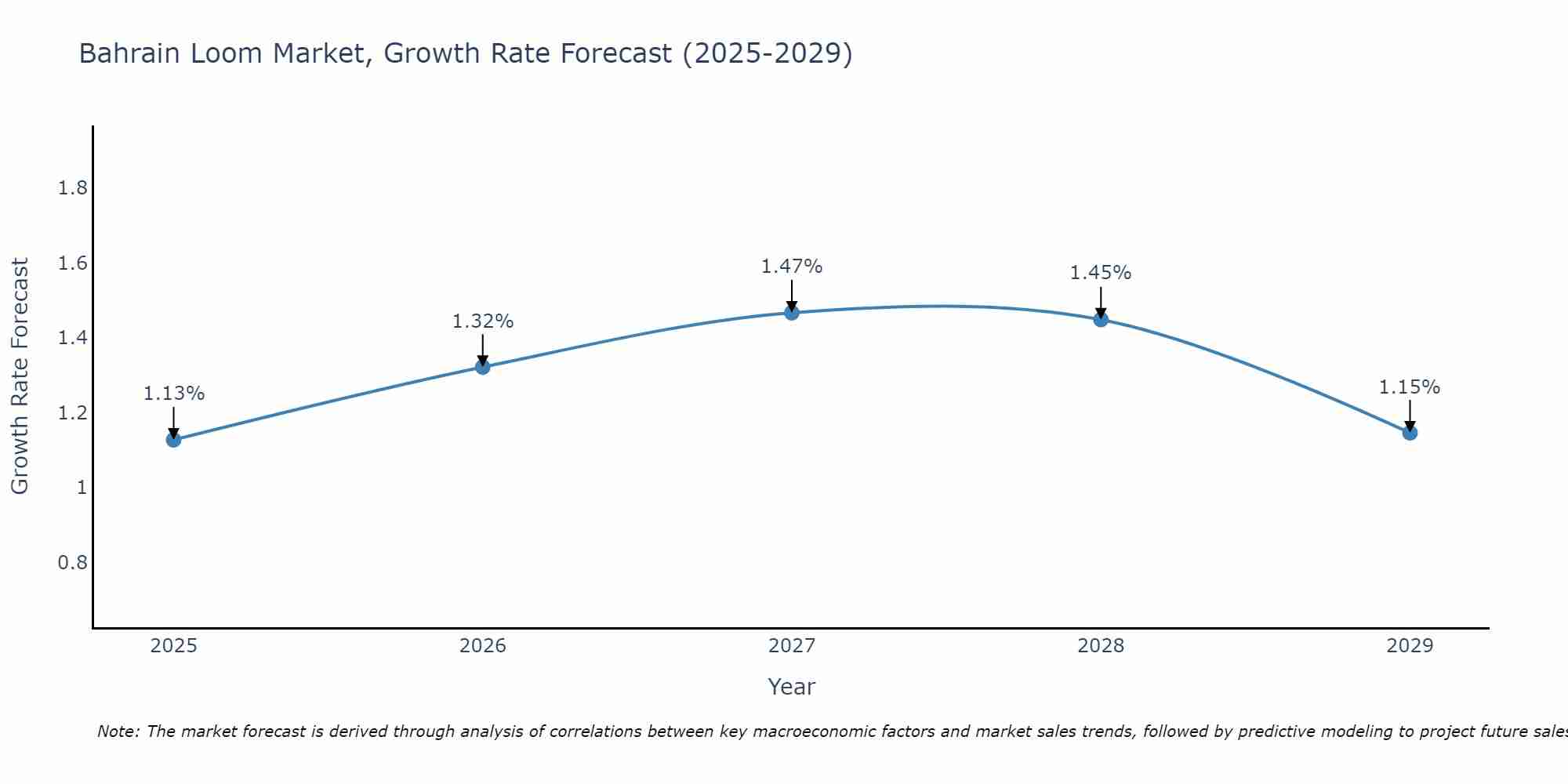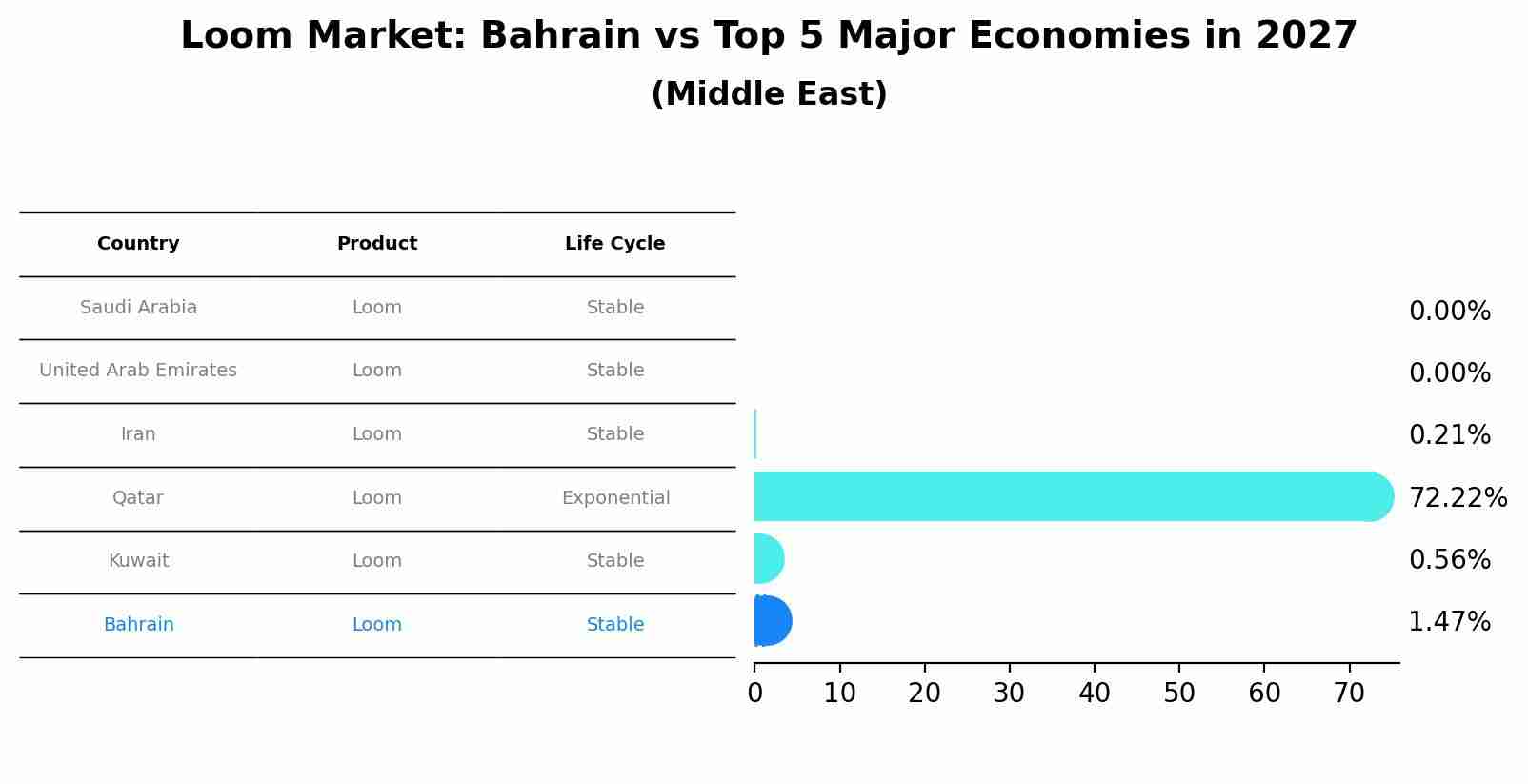Bahrain Loom Market (2025-2031) Outlook | Share, Value, Companies, Industry, Analysis, Growth, Revenue, Trends, Forecast & Size
| Product Code: ETC428860 | Publication Date: Oct 2022 | Updated Date: Aug 2025 | Product Type: Market Research Report | |
| Publisher: 6Wresearch | Author: Ravi Bhandari | No. of Pages: 75 | No. of Figures: 35 | No. of Tables: 20 |
Bahrain Loom Market Size Growth Rate
The Bahrain Loom Market is projected to witness mixed growth rate patterns during 2025 to 2029. Starting at 1.13% in 2025, the market peaks at 1.47% in 2027, and settles at 1.15% by 2029.

Loom Market: Bahrain vs Top 5 Major Economies in 2027 (Middle East)
Bahrain's Loom market is anticipated to experience a stable growth rate of 1.47% by 2027, reflecting trends observed in the largest economy Saudi Arabia, followed by United Arab Emirates, Iran, Qatar and Kuwait.

Bahrain Loom Market Synopsis
The loom market in Bahrain caters to the countrys small-scale textile and handicraft sector. While large-scale weaving is limited, manual and semi-automatic looms are used in traditional crafts and custom fabric production. Suppliers import looms for educational, cultural, and boutique production uses.
Trends of the market
Bahrains loom market is gradually expanding as interest in artisanal weaving and textile manufacturing grows. Traditional looms are being preserved in cultural centers, while modern looms are increasingly adopted by fabric producers. Investment in automatic and semi-automatic looms is helping improve productivity and reduce manual labor. With a rising trend toward sustainable and handmade textiles, small-scale loom operators are finding new market opportunities. Importation of advanced looms from Europe and Asia is common among larger textile companies. This market is also seeing synergy with tourism and heritage industries promoting local craftsmanship.
Challenges of the market
The loom market in Bahrain is relatively small due to limited domestic textile manufacturing activity. High machinery costs and the lack of skilled labor for operating and maintaining looms act as major barriers to market growth. The industry also lacks economies of scale, making it hard for local producers to compete with imported textiles. Energy consumption and mechanical wear-and-tear issues increase the total cost of ownership. Furthermore, there is minimal governmental support for reviving or expanding traditional weaving practices. Technological upgrades like smart looms are slow to penetrate the market due to cost concerns and limited awareness.
Investment opportunities in the Market
The loom market in Bahrain offers opportunities for growth, particularly with the increasing focus on textile manufacturing and garment production. Investors can take advantage of the market by offering advanced looms that improve productivity and precision in fabric production. As demand for high-quality textiles increases, there is room for innovation in automated weaving systems. Additionally, the governments push for manufacturing and export-oriented industries creates an opportunity to expand beyond local markets. Incorporating sustainable practices, such as energy-efficient machines, could further enhance competitiveness in the market.
Government Policy of the market
The loom market in Bahraincovering both manual and automated weaving machinesis supported by government policies aimed at revitalizing the textile and cottage industries. Bahrain has introduced small-scale entrepreneurship grants and simplified business registration to encourage local textile production, especially among women entrepreneurs. The Ministry of Industry and Commerce enforces quality and safety regulations on imported looms, particularly power looms and electronic systems integrated into textile units. There are also educational programs under vocational development initiatives that teach traditional and digital weaving techniques. The government occasionally supports craft fairs and textile expos that allow loom operators and artisans to showcase their work, creating market linkages. However, imports of outdated or non-compliant looms are restricted to maintain modern production standards and ensure worker safety.
Key Highlights of the Report:
- Bahrain Loom Market Outlook
- Market Size of Bahrain Loom Market, 2024
- Forecast of Bahrain Loom Market, 2031
- Historical Data and Forecast of Bahrain Loom Revenues & Volume for the Period 2021 - 2031
- Bahrain Loom Market Trend Evolution
- Bahrain Loom Market Drivers and Challenges
- Bahrain Loom Price Trends
- Bahrain Loom Porter's Five Forces
- Bahrain Loom Industry Life Cycle
- Historical Data and Forecast of Bahrain Loom Market Revenues & Volume By Type for the Period 2021 - 2031
- Historical Data and Forecast of Bahrain Loom Market Revenues & Volume By Hand Loom for the Period 2021 - 2031
- Historical Data and Forecast of Bahrain Loom Market Revenues & Volume By Shuttle Loom for the Period 2021 - 2031
- Historical Data and Forecast of Bahrain Loom Market Revenues & Volume By Modern Loom for the Period 2021 - 2031
- Historical Data and Forecast of Bahrain Loom Market Revenues & Volume By Projectile Loom for the Period 2021 - 2031
- Historical Data and Forecast of Bahrain Loom Market Revenues & Volume By Air Jet Loom for the Period 2021 - 2031
- Historical Data and Forecast of Bahrain Loom Market Revenues & Volume By Multiphase Loom for the Period 2021 - 2031
- Historical Data and Forecast of Bahrain Loom Market Revenues & Volume By Applications for the Period 2021 - 2031
- Historical Data and Forecast of Bahrain Loom Market Revenues & Volume By Home Use for the Period 2021 - 2031
- Historical Data and Forecast of Bahrain Loom Market Revenues & Volume By Commercial Use for the Period 2021 - 2031
- Bahrain Loom Import Export Trade Statistics
- Market Opportunity Assessment By Type
- Market Opportunity Assessment By Applications
- Bahrain Loom Top Companies Market Share
- Bahrain Loom Competitive Benchmarking By Technical and Operational Parameters
- Bahrain Loom Company Profiles
- Bahrain Loom Key Strategic Recommendations
Frequently Asked Questions About the Market Study (FAQs):
1 Executive Summary |
2 Introduction |
2.1 Key Highlights of the Report |
2.2 Report Description |
2.3 Market Scope & Segmentation |
2.4 Research Methodology |
2.5 Assumptions |
3 Bahrain Loom Market Overview |
3.1 Bahrain Country Macro Economic Indicators |
3.2 Bahrain Loom Market Revenues & Volume, 2021 & 2031F |
3.3 Bahrain Loom Market - Industry Life Cycle |
3.4 Bahrain Loom Market - Porter's Five Forces |
3.5 Bahrain Loom Market Revenues & Volume Share, By Type, 2021 & 2031F |
3.6 Bahrain Loom Market Revenues & Volume Share, By Applications, 2021 & 2031F |
4 Bahrain Loom Market Dynamics |
4.1 Impact Analysis |
4.2 Market Drivers |
4.2.1 Increasing demand for traditional Bahraini textiles and garments |
4.2.2 Growth in the tourism industry leading to higher demand for locally-made textiles |
4.2.3 Government initiatives to promote Bahraini craftsmanship and heritage |
4.3 Market Restraints |
4.3.1 Competition from imported textiles and garments |
4.3.2 Fluctuations in raw material prices impacting production costs |
4.3.3 Limited availability of skilled artisans and weavers |
5 Bahrain Loom Market Trends |
6 Bahrain Loom Market, By Types |
6.1 Bahrain Loom Market, By Type |
6.1.1 Overview and Analysis |
6.1.2 Bahrain Loom Market Revenues & Volume, By Type, 2021 - 2031F |
6.1.3 Bahrain Loom Market Revenues & Volume, By Hand Loom, 2021 - 2031F |
6.1.4 Bahrain Loom Market Revenues & Volume, By Shuttle Loom, 2021 - 2031F |
6.1.5 Bahrain Loom Market Revenues & Volume, By Modern Loom, 2021 - 2031F |
6.1.6 Bahrain Loom Market Revenues & Volume, By Projectile Loom, 2021 - 2031F |
6.1.7 Bahrain Loom Market Revenues & Volume, By Air Jet Loom, 2021 - 2031F |
6.1.8 Bahrain Loom Market Revenues & Volume, By Multiphase Loom, 2021 - 2031F |
6.2 Bahrain Loom Market, By Applications |
6.2.1 Overview and Analysis |
6.2.2 Bahrain Loom Market Revenues & Volume, By Home Use, 2021 - 2031F |
6.2.3 Bahrain Loom Market Revenues & Volume, By Commercial Use , 2021 - 2031F |
7 Bahrain Loom Market Import-Export Trade Statistics |
7.1 Bahrain Loom Market Export to Major Countries |
7.2 Bahrain Loom Market Imports from Major Countries |
8 Bahrain Loom Market Key Performance Indicators |
8.1 Percentage increase in the number of tourists purchasing Bahraini textiles |
8.2 Growth in the number of local textile businesses utilizing traditional weaving techniques |
8.3 Percentage of government funding allocated to support the Bahraini loom market |
8.4 Average time taken to train a new artisan in traditional weaving techniques |
9 Bahrain Loom Market - Opportunity Assessment |
9.1 Bahrain Loom Market Opportunity Assessment, By Type, 2021 & 2031F |
9.2 Bahrain Loom Market Opportunity Assessment, By Applications, 2021 & 2031F |
10 Bahrain Loom Market - Competitive Landscape |
10.1 Bahrain Loom Market Revenue Share, By Companies, 2024 |
10.2 Bahrain Loom Market Competitive Benchmarking, By Operating and Technical Parameters |
11 Company Profiles |
12 Recommendations |
13 Disclaimer |
- Single User License$ 1,995
- Department License$ 2,400
- Site License$ 3,120
- Global License$ 3,795
Search
Related Reports
- ASEAN Bearings Market (2025-2031) | Strategy, Consumer Insights, Analysis, Investment Trends, Opportunities, Growth, Size, Share, Industry, Revenue, Segments, Value, Segmentation, Supply, Forecast, Restraints, Outlook, Competition, Drivers, Trends, Demand, Pricing Analysis, Competitive, Strategic Insights, Companies, Challenges
- Europe Flooring Market (2025-2031) | Outlook, Share, Industry, Trends, Forecast, Companies, Revenue, Size, Analysis, Growth & Value
- Saudi Arabia Manlift Market (2025-2031) | Outlook, Size, Growth, Trends, Companies, Industry, Revenue, Value, Share, Forecast & Analysis
- Uganda Excavator, Crane, and Wheel Loaders Market (2025-2031) | Strategy, Consumer Insights, Analysis, Investment Trends, Opportunities, Growth, Size, Share, Industry, Revenue, Segments, Value, Segmentation, Supply, Forecast, Restraints, Outlook, Competition, Drivers, Trends, Demand, Pricing Analysis, Competitive, Strategic Insights, Companies, Challenges
- Rwanda Excavator, Crane, and Wheel Loaders Market (2025-2031) | Strategy, Consumer Insights, Analysis, Investment Trends, Opportunities, Growth, Size, Share, Industry, Revenue, Segments, Value, Segmentation, Supply, Forecast, Restraints, Outlook, Competition, Drivers, Trends, Demand, Pricing Analysis, Competitive, Strategic Insights, Companies, Challenges
- Kenya Excavator, Crane, and Wheel Loaders Market (2025-2031) | Strategy, Consumer Insights, Analysis, Investment Trends, Opportunities, Growth, Size, Share, Industry, Revenue, Segments, Value, Segmentation, Supply, Forecast, Restraints, Outlook, Competition, Drivers, Trends, Demand, Pricing Analysis, Competitive, Strategic Insights, Companies, Challenges
- Angola Excavator, Crane, and Wheel Loaders Market (2025-2031) | Strategy, Consumer Insights, Analysis, Investment Trends, Opportunities, Growth, Size, Share, Industry, Revenue, Segments, Value, Segmentation, Supply, Forecast, Restraints, Outlook, Competition, Drivers, Trends, Demand, Pricing Analysis, Competitive, Strategic Insights, Companies, Challenges
- Israel Intelligent Transport System Market (2025-2031) | Strategy, Consumer Insights, Analysis, Investment Trends, Opportunities, Growth, Size, Share, Industry, Revenue, Segments, Value, Segmentation, Supply, Forecast, Restraints, Outlook, Competition, Drivers, Trends, Demand, Pricing Analysis, Competitive, Strategic Insights, Companies, Challenges
- Uganda Precast and Aggregate Market (2025-2031) | Strategy, Consumer Insights, Analysis, Investment Trends, Opportunities, Growth, Size, Share, Industry, Revenue, Segments, Value, Segmentation, Supply, Forecast, Restraints, Outlook, Competition, Drivers, Trends, Demand, Pricing Analysis, Competitive, Strategic Insights, Companies, Challenges
- Australia IT Asset Disposal Market (2025-2031) | Strategy, Consumer Insights, Analysis, Investment Trends, Opportunities, Growth, Size, Share, Industry, Revenue, Segments, Value, Segmentation, Supply, Forecast, Restraints, Outlook, Competition, Drivers, Trends, Demand, Pricing Analysis, Competitive, Strategic Insights, Companies, Challenges
Industry Events and Analyst Meet
Our Clients
Whitepaper
- Middle East & Africa Commercial Security Market Click here to view more.
- Middle East & Africa Fire Safety Systems & Equipment Market Click here to view more.
- GCC Drone Market Click here to view more.
- Middle East Lighting Fixture Market Click here to view more.
- GCC Physical & Perimeter Security Market Click here to view more.
6WResearch In News
- Doha a strategic location for EV manufacturing hub: IPA Qatar
- Demand for luxury TVs surging in the GCC, says Samsung
- Empowering Growth: The Thriving Journey of Bangladesh’s Cable Industry
- Demand for luxury TVs surging in the GCC, says Samsung
- Video call with a traditional healer? Once unthinkable, it’s now common in South Africa
- Intelligent Buildings To Smooth GCC’s Path To Net Zero













